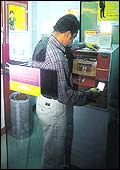|
 The
stodgy old neighbourhood bank turned hip in the late 1990s. Its
new tech-savvy, swish avatar is customer-friendly and convenient.
Its products, basically either loans or deposits, have snazzy names
and use catchy advertising to lure customers. No longer is a loan
just a mundane, no-frills loan. It comes with customised toppings.
Ditto for deposits. Flexi-schemes, variable interest rates, unfixed
fixed deposits... you name it, they have it. The
stodgy old neighbourhood bank turned hip in the late 1990s. Its
new tech-savvy, swish avatar is customer-friendly and convenient.
Its products, basically either loans or deposits, have snazzy names
and use catchy advertising to lure customers. No longer is a loan
just a mundane, no-frills loan. It comes with customised toppings.
Ditto for deposits. Flexi-schemes, variable interest rates, unfixed
fixed deposits... you name it, they have it.
Increasing adoption of technology, whether
it was for reaching out to the customer more efficiently through
seamless virtual networks or for overhauling and modernising backroom
operations in the underbelly of banks, was Indian banking's most
visible development in the 1990s. It was a corollary, really, of
competition.
For, two decades after an earlier avatar of
the government (a socialist one, of course) had nationalised banks,
it opened up the industry to new private sector entrants. If that
was a spur to the start of new competition among Indian banks, there
was more. From a centralised control over interest rates, the Reserve
Bank of India (RBI) ushered in a regime where interest rates were
more in line with market forces, allowing banks to offer flexible
rates, depending on their risk perception of the borrowers.
As banking became less regulated, the customer
benefited. But there was a less savoury flipside to it. For decades
the public sector banks had played the main role in resource mobilisation
and economic development, particularly in the rural and weaker sections
of the economy. Banking did spread and in 1990, the share of banks
in the total financial assets as an aggregate amounted to two-thirds.
But the real problem was a regime of administered prices, scarce
products and few players. The lack of competition inhibited innovation
and state-ownership led to political meddling in their functioning.
Governments used banks to carry out populist measures like large-scale
loan melas and generous credit to the weaker sections. This and
their obsession to grow led to serious crises. At the end of the
1990s, banks as well as several of the development financial institutions
were saddled with non-performing assets (read bad and unrecoverable
debt) that touched a massive Rs 75,000 crore. Few will be surprised
if some of them go belly-up.
There were other, less unpleasant developments
during the decade. By the mid-1990s, the near-monopoly of public
sector banks started getting eroded by the more customer-focused
private sector entrants. It was competition that helped force older
banks to revitalise their operations.
The other benefit by default for banks was
the migration of money from a scam-tainted stock market. Beginning
1992, larger proportions of household savings moved into the banking
system. It was a windfall for banks, which recorded an annual growth
of 20 per cent growth in deposits through the 1990s. To put it pithily,
it was an era when Indian banking not only grew but also appeared
to mature.
The Nationalisation Of Banks
1969 wasn't just
the year man set foot on the moon or Woodstock happened; it was
also the year Indira Gandhi nationalised 14 private sector banks.
Prior to that most banks like Central Bank (owned by the Tatas),
United Commercial Bank (Birlas) and Syndicate Bank (Pais) were owned
and managed by businessmen. The only exception was the State Bank
of India. Known as the Imperial Bank of India before 1955, this
came under the purview of the Reserve Bank of India; it had been
nationalised in July 1955 under the SBI Act of 1955. The businessmen
who owned these banks channelised most deposits into their own companies,
often ignoring the government's focus areas, agriculture and small-scale
industries.
That neglect was one reason for the nationalisation
of banks. Another was Gandhi's desire to spread the banking habit
in rural and semi-urban areas, freeing farmers from the clutches
of usurious money-lenders. And still another was the odd name like
Nath Bank that went bust.
-Ashish Gupta
NATIONALISATINO: A CHRONOLOGY
|
|
| Indira Gandhi: prime mover |
1949: Enactment of Banking Regulation
Act
1955: (Phase I): Nationalisation of State Bank of
India
1959: (Phase II): Nationalisation of SBI subsidiaries
1961: Insurance cover extended to deposits
1969 (Phase III): Nationalisation of 14 major banks
1971: Creation of Credit Guarantee Corporation
1975: Creation of regional rural banks
1980 (Phase IV): Nationalisation of six banks with deposits
over Rs 200 crore
The Emergence Of New Private
Banks
|
|
| Indira Gandhi: prime mover |
The eight new private
banks that have emerged on the Indian financial topography since
1994 are clear outperformers in an otherwise troubled sector. In
seven years, these banks have grown to account for six per cent
of the total assets and 10 per cent of the total profits of the
banking industry (circa 2000-01).
It was the Narasimham committee report dated
1991 that envisaged a larger role for private sector banks. The
Reserve Bank of India agreed, and in an effort to make the sector
more efficient and competitive, it issued, in January 1993, the
guidelines governing the entry of new private banks-a minimum paid-up
capital of Rs 100 crore among others. This was the first time, following
the nationalisation of banks in 1969, that the RBI was issuing fresh
banking licences to the private sector.
The NPBs have grown not just organically, but
also through mergers and acquisitions. HDFC Bank merged with Times
Bank in an all-stock deal valued at Rs 200 crore in November 1999;
ICICI Bank acquired Bank of Madura in a stock-swap deal in December
2000 to become the largest among the NPBs.
Today, both ICICI Bank and HDFC Bank are listed
on NYSE, and show no signs of letting up on their retail offensive.
As on March 2001, ICICI Bank had set up 510 ATMs (Automated Teller
Machines); HDFC Bank, 350. In general, the new private banks have
rapidly taken to technology. On most operating parameters the NPBs
outscore their public sector brethren, but all is not well in the
category. Lower interest rates are impacting bottomlines adversely,
and asset quality has been hit by the economic downturn. The number
of NPBs could shrink in the next few years: Centurion Bank, Bank
of Punjab, Global Trust Bank, and Indus Ind in all probability will
be acquired by another bank.
-Roshni Jayakar
The
Emergence Of Universal Banks
 Get
ready to welcome the supermarkets of the banking business. They're
called universal banks and they will provide a clutch of services
from retail and corporate banking to ndustrial lending, investment
banking to insurance. In April 2001, the RBI drafted a blueprint
for financial institutions wishing to convert themselves into universal
banks. In October, ICICI put in its application to become one by
effecting a reverse merger with ICICI Bank; within a month, the
RBI had cleared this in principle. IDBI has also made out a case
for becoming a universal bank by merging into IDBI Bank or taking
over a public sector bank and merging with it. While HDFC has ruled
out the possibility of it merging with HDFC Bank, we certainly haven't
seen the last of u-bank applicants. It does make sense for FIs to
transform into u-banks: most were competing with banks in raising
short-term funds; and they were often funding long-term projects
leading to asset-liability mismatches. Put simply, the U-B route
could indirectly address the issue of non performing assets that
plagues FIs. Amen. Get
ready to welcome the supermarkets of the banking business. They're
called universal banks and they will provide a clutch of services
from retail and corporate banking to ndustrial lending, investment
banking to insurance. In April 2001, the RBI drafted a blueprint
for financial institutions wishing to convert themselves into universal
banks. In October, ICICI put in its application to become one by
effecting a reverse merger with ICICI Bank; within a month, the
RBI had cleared this in principle. IDBI has also made out a case
for becoming a universal bank by merging into IDBI Bank or taking
over a public sector bank and merging with it. While HDFC has ruled
out the possibility of it merging with HDFC Bank, we certainly haven't
seen the last of u-bank applicants. It does make sense for FIs to
transform into u-banks: most were competing with banks in raising
short-term funds; and they were often funding long-term projects
leading to asset-liability mismatches. Put simply, the U-B route
could indirectly address the issue of non performing assets that
plagues FIs. Amen.
-Roshni Jayakar
Virtual Bank, Real Service
 |
| ATMs are fast-eroding the old branch networks'
significance |
In terms of technology,
there is a great divide between the old public sector banks on on
side and the new private banks and foreign banks on another. Even
accepting the logic that it is easier for foreign banks, with their
limited branch network to adopt technology, age and heredity seem
to define the boundary between technologically advanced banks and
their backward peers. Indeed, NPBs like HDFC Bank and ICICI Bank
have managed to leverage technology to centralise their back-ends,
reduce the number of people manning their front-end, and cut transaction
costs. The ATM, phone, and the internet are rapidly eroding the
significance of a branch-network. Some public sector banks, like
SBI, Bank of Baroda, and Corporation Bank, have made some progress,
but the road ahead is long. More than anything else, the growth
of retail banking in the country has been facilitated by technology.
Most customers of the NPBs and foreign banks conduct most transactions
through ATM or telephone. Their ATM cards often double up as debit
cards.
In retrospect, if there is one event that set
banks down the tech-path, it must be Citibank's Millennium Banking
project that resulted in the low-cost service branded Suvidha. By
using technology and encouraging customers to conduct transactions
by phone, over the net, or through ATMs, the bank managed to lower
transaction costs enough to mass-base its offerings. Unfortunately,
by the time Citibank was through with its pilot in Bangalore and
ready to roll out its services in Mumbai and Delhi, HDFC Bank and
ICICI Bank had caught on to the benefits of adopting technology.
The rest of the story is there to see in your neighbourhood ATM
outlet.
-Roshni Jayakar
The
Problem Of NPAs
It is one problem
that refuses to go away. From Rs 53,066 crore in March 2000, the
Non Performing Assets (NPAs) of the 27 public sector banks shot
up to Rs 56,608 crore in September 2001. This staggering number
not only reduces the yield on advances but also has an adverse impact
on the profitability of banks. The stratagem of using Debt Recovery
Tribunals to recover dues has failed miserably. Unless something
is done about the prevalent laws concerning bad debts, banks will
have no option but to continue to carry the baggage of NPAs. ''The
huge NPAs of the banks is mostly because of the debtor-friendly
foreclosure and bankruptcy laws which allows customers to default
with impunity,'' contends a banker.
-Ashish Gupta
Plastic Power
Has the plastic
culture caught on in India? It would seem so. India has 5.3 million
credit cards and 6.5 lakh debit cards. The average spend on a credit
card, at Rs 22,000 a year, is high enough to bring a smile to the
lips of the most phlegmatic of bankers. That number, says Pushpendara
Mehta of the Credit Card management Consultancy, should go up by
30-35 per cent a year over the next two to three years. And debit
cards, according to Venture Infotek, could see triple-digit growth
this year with most banks converting their ATM cards to debit cards.
The future, clearly, is in plastic.
-Roshni Jayakar
|

